Mechanism and Measurement of Coordinated Development in the Mariculture Ecological–Economic–Social Complex System: A Case Study of China
Abstract
1. Introduction
2. The CDM of the MEES Complex System
2.1. The Connotation of the MEES Complex System’s Coordinated Development
2.2. The Goal of the MEES Complex System’s Coordinated Development
2.2.1. Benefit Enhancement Goal
2.2.2. Synergy Optimization Goal
2.2.3. Sustainable Development Goal
2.3. The Hierarchical Structure for the MEES Complex System’s Coordinated Development
2.3.1. Coordinated Development Within the Subsystems
- (1)
- Coordinated development within the mariculture ecological system
- (2)
- Coordinated development within the mariculture economic system
- (3)
- Coordinated development within the mariculture social system
2.3.2. Coordinated Development Between Subsystems
- (1)
- Coordinated development between mariculture ecological system and mariculture economic system
- (2)
- Coordinated development between mariculture ecological system and mariculture social system
- (3)
- Coordinated development between mariculture economic system and mariculture social system
- (4)
- Coordinated development between mariculture ecological system, mariculture economic system and mariculture social system
2.3.3. Coordinated Development of the MEES Complex System as a Whole
3. Data and Methodology
3.1. Data Sources
3.2. Indicator System Constructed
3.3. Data Standardization and Indicator Empowerment
3.3.1. Data Standardization
3.3.2. Indicator Empowerment
3.4. Research Methods
3.4.1. Comprehensive Development Index (CDI)
3.4.2. CCD Model
4. Results
4.1. The CDL of Complex System and Its Subsystems
4.1.1. The CDL of the MEES Complex System
4.1.2. The Development Level of Mariculture Ecological System
4.1.3. The Development Level of the Mariculture Economic System
4.1.4. The Development Level of Mariculture Social System
4.2. The CCD of the MEES Complex System
5. Discussion
6. Conclusions
- (1)
- Deepening basic research to preliminarily explore the interaction mechanisms between aquaculture activities and marine ecosystems, providing scientific support for the precise regulation of aquaculture capacity and the optimization of environmental management;
- (2)
- Accelerating intelligent empowerment through internet of things, big data, and artificial intelligence technologies to establish a smart aquaculture management platform, enabling initial precision control over water quality monitoring, feeding regulation, and disease early warning;
- (3)
- In regions where conditions permit, small-scale pilot projects integrating aquaculture with tourism or science education may be considered as appropriate, to conduct preliminary assessments of their potential for enhancing economic value-added and ecological compatibility.
Author Contributions
Funding
Data Availability Statement
Acknowledgments
Conflicts of Interest
Abbreviations
| CCD | Coupling coordination degree |
| CDEIS | Coordinated development evaluation indicator system |
| CDI | Comprehensive development index |
| CDL | Comprehensive development level |
| CDM | Coordinated development mechanism |
| EES | Ecological–economic–social |
| ESE | Economic–social–environmental |
| MCDM | Multi-criteria decision-making |
| MEES | Mariculture ecological–economic–social |
References
- Steele, J.H.; Turekian, K.K.; Thorpe, S.A. Encyclopedia of Ocean Sciences, 2nd ed.; Academic Press: Oxford, UK, 2009; pp. 537–544. [Google Scholar]
- Jie, X.; Limin, H.; Wei, Y. Research on the ecologicalization efficiency of mariculture industry in China and its influencing factors. Mar. Policy 2022, 137, 104935. [Google Scholar] [CrossRef]
- Alleway, K.H.; Gillies, L.C.; Bishop, J.M.; Gentry, R.R.; Theuerkauf, S.J.; Jones, R. The Ecosystem Services of Marine Aquaculture: Valuing Benefits to People and Nature. BioScience 2019, 69, 59–68. [Google Scholar] [CrossRef]
- Liu, Y.; Wang, Z.; Yang, X.; Wang, S.; Liu, X.; Liu, B.; Zhang, J.; Meng, D.; Ding, K.; Gao, K.; et al. Changes in mariculture and offshore seawater quality in China during the past 20 years. Ecol. Indic. 2023, 157, 111220. [Google Scholar] [CrossRef]
- Meng, W.; Feagin, A.R. Mariculture is a double-edged sword in China. Estuar. Coast. Shelf Sci. 2019, 222, 147–150. [Google Scholar] [CrossRef]
- Fu, X.M.; Zhang, M.Q.; Liu, Y.; Shao, C.L.; Hu, Y.; Wang, X.Y.; Su, L.R.; Wang, N.; Wang, C.Y. Protective exploitation of marine bioresources in China. Ocean Coast. Manag. 2018, 163, 192–204. [Google Scholar] [CrossRef]
- Yu, J.K.; Han, Q.C. Food security of mariculture in China: Evolution, future potential and policy. Mar. Policy. 2020, 115, 103892. [Google Scholar] [CrossRef]
- Yu, J.K.; Wang, Y. Exploring stakeholder engagement in mariculture development: Challenges and prospects for China. Mar. Policy 2019, 103, 84–90. [Google Scholar] [CrossRef]
- Feng, Y.Y.; Hou, L.C.; Ping, N.X.; Ling, T.D.; Kyo, C.I. Development of mariculture and its impacts in Chinese coastal waters. Rev. Fish Biol. Fish. 2005, 14, 1–10. [Google Scholar] [CrossRef]
- FAO. The State of World Fisheries and Aquaculture 2024; Blue Transformation in action; FAO: Rome, Italy, 2024. [Google Scholar]
- Ren, W.H. What forces drive the rapid development of mariculture in China: Factor-driven or total factor productivity-driven? Aquac. Res. 2021, 52, 3966–3977. [Google Scholar] [CrossRef]
- Li, Q.; Kijima, A. Current Status and Problems of Mariculture in China. Aquac. Sci. 2002, 50, 129–132. (In Japanese) [Google Scholar] [CrossRef]
- Zhang, J.; Wu, W.; Li, Y.; Liu, Y.; Wang, X. Environmental effects of mariculture in China: An overall study of nitrogen and phosphorus loads. Acta Oceanol. Sinica 2022, 41, 4–11. [Google Scholar] [CrossRef]
- Qin, H.; Ye, C.C.; Zhang, Y. Research on the evaluation of the state of marine aquaculture ecological and economic system--Taking Shandong Province as an example. Econ. Issues 2017, 76, 100–105+113. (In Chinese) [Google Scholar] [CrossRef]
- Ding, Y.T. Evaluation of coupled ecological-economic-social system synergistic development of wetlands in the Minjiang estuary. China Fish. Econ. 2020, 38, 55–64. (In Chinese) [Google Scholar]
- Zhang, Y.; Ji, J.Y. Decomposition of coupled relationships and drivers of ecological and economic systems of mariculture in China. Agric. Technol. Econ. 2020, 4, 94–106. (In Chinese) [Google Scholar] [CrossRef]
- Zhang, W.; Zhang, X.; Zhang, M.; Li, W. How to Coordinate Economic, Logistics and Ecological Environment? Evidences from 30 Provinces and Cities in China. Sustainability 2020, 12, 1058. [Google Scholar] [CrossRef]
- Xie, M.; Wang, J.; Chen, K. Coordinated Development Analysis of the “Resources-Environment-Ecology-Economy-Society” Complex System in China. Sustainability 2016, 8, 582. [Google Scholar] [CrossRef]
- Holling, C.S. Understanding the complexity of economic, ecological, and social systems. Ecosystems 2001, 4, 390–405. [Google Scholar] [CrossRef]
- Beria, L.; Meine, V.N.; Sean, K.; Sara, N.; Peter, A.M. Synthesis and Lessons on Ecological, Economic, Social and Governance Propositions. In Co-Investment in Ecosystem Services: Global Lessons from Payment and Incentive Schemes; Beria, L., Meine, V.N., Sean, K., Sara, N., Peter, A.M., Eds.; World Agroforestry (ICRAF): Nairobi, Kenya, 2018; Chapter 38; pp. 511–538. [Google Scholar]
- Wang, N.; Li, J.M.; Zhou, Y.F. Mechanism of action of marine ecological restoration on ecological, economic, and social benefits—An empirical analysis based on a structural equation model. Ocean Coast. Manag. 2024, 248, 106950. [Google Scholar] [CrossRef]
- Li, Y.; Hao, H.; Sun, L.; Liu, M.; Wang, D. The Development of Economic–Social–Ecological Complex Systems in the Yellow River Basin, China. Sustainability 2025, 17, 511. [Google Scholar] [CrossRef]
- Gao, Y.; Bai, L.; Zhou, K.; Kou, Y.; Yuan, W.; Zhou, X.; Qiu, Z.; Zhao, D.; Lv, Z.; Wu, Q.; et al. Study on the Coupling Coordination Degree and Driving Mechanism of “Production-Living-Ecological” Space in Ecologically Fragile Areas: A Case Study of the Turpan–Hami Basin. Sustainability 2024, 16, 9054. [Google Scholar] [CrossRef]
- Dong, G.; Ge, Y.; Liu, J.; Kong, X.; Zhai, R. Evaluation of coupling relationship between urbanization and air quality based on improved coupling coordination degree model in Shandong Province, China. Ecol. Indic. 2023, 154, 110578. [Google Scholar] [CrossRef]
- Garza-Gil, D.M.; Surís-Regueiro, C.J.; Varela-Lafuente, M.M. Using input–output methods to assess the effects of fishing and aquaculture on a regional economy: The case of Galicia, Spain. Mar. Policy 2017, 85, 48–53. [Google Scholar] [CrossRef]
- Raffray, M.; Martin, J.; Jacob, C. Socioeconomic impacts of seafood sectors in the European Union through a multi-regional input output model. Sci. Total Environ. 2022, 850, 157989. [Google Scholar] [CrossRef]
- Li, M.; Niu, C.; Li, X.; Quan, L.; Li, W.; Liu, C.; Shi, C.; Soomro, S.-E.; Song, Q.; Hu, C. Modeling and Evaluating the Socio-Economic–Flood Safety–Ecological System of Landong Floodplain Using System Dynamics and the Weighted Coupling Coordination Degree Model. Water 2024, 16, 2366. [Google Scholar] [CrossRef]
- Wang, A.; Liang, S.; Wang, S. Coupling coordination development of water resources-economy-ecology system in Shanxi Province based on system dynamics. Sci. Rep. 2025, 15, 7370. [Google Scholar] [CrossRef]
- Sun, L. Driving Mechanism of the Coordinated Development of Regional Economy-Society-Environment System Based on Grey Incidence Analysis Model—A Case Study of Wanjiang Urban Belt. Mod. Econ. 2020, 11, 1226–1244. [Google Scholar] [CrossRef]
- Wang, Y.; Pan, H.; Li, S.; Failler, P. An integrated socio-economic and ecological framework for evaluating the societal costs and benefits of fishing activities in the Pearl River Delta. Open J. Mar. Sci. 2015, 5, 477–497. [Google Scholar] [CrossRef]
- Peng, D.; Mu, Y.; Zhu, Y. Evaluating the level of coordinated development of fisheries economic growth and environmental quality in selected Chinese regions. Environ. Impact Assess. Rev. 2021, 89, 106605. [Google Scholar] [CrossRef]
- Luo, D.; Liang, L.W.; Wang, Z.; Chen, L.; Zhang, F. Exploration of coupling effects in the Economy–Society–Environment system in urban areas: Case study of the Yangtze River Delta Urban Agglomeration. Ecol. Indic. 2021, 128, 107858. [Google Scholar] [CrossRef]
- Wu, Y.; Zhong, C.; Wu, Y. Ecological Efficiency Evaluation and Development Trend Prediction of Marine Aquaculture Industry: A Case Study of Weihai City, China. Sustainability 2025, 17, 968. [Google Scholar] [CrossRef]
- Zhang, X.; Zhong, L.; Yu, H.; Wang, L.E. Sustainability Assessment for the Protected Area Tourism System from the Perspective of Ecological-Economic-Social Coordinated Development. Forests 2023, 14, 890. [Google Scholar] [CrossRef]
- Wang, T.; Yang, Z.; Han, F.; Yu, J.; Ma, X.; Han, J. Assessment of tourism socio-ecological system resilience in arid areas: A case study of xinnjiang, China. Ecol. Indic. 2024, 159, 111748. [Google Scholar] [CrossRef]
- Qu, L.; Tu, Z.; Liu, J.; Li, Y. Coupling coordination evolution of the settlements-farming system and its optimization path: Keys to sustainable rural development in the Three Gorges Reservoir Area of China. Habitat Int. 2025, 163, 103456. [Google Scholar] [CrossRef]
- Fang, C.L.; Liu, H.M.; Li, G.D. International progress and evaluation on interactive coupling effects between urbanization and the eco-environment. J. Geogr. Sci. 2016, 26, 1081–1116. [Google Scholar] [CrossRef]
- Sun, Q.; Zhang, X.; Zhang, H.; Niu, H. Coordinated development of a coupled social economy and resource environment system: A case study in Henan Province, China. Environ. Dev. Sustain. 2018, 20, 1385–1404. [Google Scholar] [CrossRef]
- Yang, S.Q.; Yang, Z.L.; GAO, W.S. Influence of different harmony functions on the harmony degree of ecology-economy-society system—A case study from Ziyang District, Yiyang City, Hunan Province. China J. Eco-Agric. 2007, 15, 151–154. (In Chinese) [Google Scholar]
- Qin, H.; Zhang, Y.; Ye, C.C. Research on the concept and composition of mariculture ecological economic system. Mar. Sci. 2017, 41, 110–116. (In Chinese) [Google Scholar] [CrossRef]
- Eraslan, E.C. The Effects of Decomposers in Marine Ecosystems. Prof. Dr. Ahmet Aksoy 2023, 21. Available online: https://www.defineabc.com/scholar?q=THE+EFFECTS+OF+DECOMPOSERS+IN+MARINE+ECOSYSTEMS (accessed on 16 December 2024).
- Dong, S.L.; Gao, Q.F.; Li, L. Aquaculture Ecosystem. In Aquaculture Ecology; Springer Nature: Singapore, 2023; pp. 33–91. [Google Scholar] [CrossRef]
- Me, B. What is synergy. Pharmacol. Rev. 1989, 41, 93–141. [Google Scholar] [CrossRef]
- Geary, N. Understanding synergy. Am. J. Physiol.-Endocrinol. Metab. 2013, 304, E237–E253. [Google Scholar] [CrossRef]
- Heinberg, R.; Lerch, D. What is sustainability. Post Carbon Reader 2010, 11, 19. Available online: https://kh.aquaenergyexpo.com/wp-content/uploads/2024/01/What-is-Sustainability.pdf (accessed on 2 March 2025).
- Giovannoni, E.; Fabietti, G. What Is Sustainability? A Review of the Concept and Its Applications. In Integrated Reporting; Busco, C., Frigo, M., Riccaboni, A., Quattrone, P., Eds.; Springer: Cham, Switzerland, 2013. [Google Scholar] [CrossRef]
- Andrii, S. Evaluating the Performance of Subjective Weighting Methods for Multi-Criteria Decision-Making using a novel Weights Similarity Coefficient. Procedia Comput. Sci. 2023, 225, 4785–4794. [Google Scholar] [CrossRef]
- Aleksandra, B.; Jarosław, W. Crispyn—A Python library for determining criteria significance with objective weighting methods. SoftwareX 2022, 19, 101166. [Google Scholar] [CrossRef]
- Singh, T.; Singh, V.; Ranakoti, L.; Kumar, S. Optimization on tribological properties of natural fiber reinforced brake friction composite materials: Effect of objective and subjective weighting methods. Polym. Test. 2023, 117, 107873. [Google Scholar] [CrossRef]
- Mittal, K.K. Vardhan A. A methodology for part family formation in reconfigurable manufacturing systems using Shannon’s entropy method. Proc. Inst. Mech. Eng. Part E J. Process Mech. Eng. 2025, 239, 1281–1295. [Google Scholar] [CrossRef]
- Yi, C.X. Design of a Multi-Indicator Evaluation System for Art Students’ Learning Outcomes Driven by Neural Networks: Weight Optimization Using the Entropy Method. Int. J. High Speed Electron. Syst. 2025, 2540554. [Google Scholar] [CrossRef]
- Gao, L.H. Measurement and Optimization Mechanism of Coordinated Development of Marine Ecological and Economic Systems in China; Ocean University of China: Qingdao, China, 2012. [Google Scholar]
- Wang, J.; Ding, H.; Zheng, H. Research on coordinated development of urbanization in Shandong Province based on improved coupled coordination model. Sci. Technol. Prog. Countermeas. 2018, 35, 29–35. (In Chinese) [Google Scholar]
- State Environmental Protection Administration. Environmental Protection Industry Standard of the People’s Republic of China; China Environmental Science Press: Beijing, China, 2008. [Google Scholar]
- The State Council Information Office of the PRC. Outline of the Twelfth Five-Year Plan for National Economic and Social Development of the PRC. 2011. Available online: http://www.scio.gov.cn/ztk/xwfb/27/8/Document/884557/884557_1.htm. (accessed on 15 March 2025).
- Pei, R.; Zhang, H.; Liu, Z.; Yu, C.; Zhang, Y.; Mu, Y. Evaluating the green development level of marine molluscan shellfish aquaculture industry and analyzing obstacle factors that hinder its improvement: The case of China. Aquaculture 2025, 606, 742603. [Google Scholar] [CrossRef]
- Tong, Y.S.; Wan, J. China’s Supply-Side Reform: The Rationale and Implications. East Asian Policy 2016, 8, 11. [Google Scholar] [CrossRef]
- Yu, K.Z. Fighting the Fishery Transformation and Structural Adjustment “Six Hard Battles”. China Fishery News, 23 May 2016; A01. [Google Scholar]
- Ministry of Natural Resources of the People’s Republic of China. State Oceanic Administration Releases 2013 Bulletin on the State of China’s Marine Environment. 2013. Available online: https://www.mnr.gov.cn/dt/hy/201403/t20140326_2331958.html (accessed on 20 March 2025).
- NOAA. Aquaculture: Bringing American-Farmed Seafood to Your Plate. NOAA Fisheries Office of Aquaculture. 2023. Available online: https://www.noaa.gov/node/275 (accessed on 18 September 2025).
- Toomey, L.; Alfonso, S.; Carbonara, P.; Jahrl, I.; Mente, E.; Lampkin, N.; Lembo, G. Unlocking the Potential of Organic Aquaculture in the EU: A Review of Policy Support and Supporting and Constraining Factors. Rev. Aquac. 2025, 17, 68–88. [Google Scholar] [CrossRef]
- Kim, Y.O. Effects of Different Feeding Frequency on the Growth, Feed utilization and Body Composition of Juvenile Eel Anguilla japonica in Semi-RAS (Recirculating Aquaculture System). J. FISHRIES Mar. Sci. Educ. 2023, 35, 412–420. [Google Scholar] [CrossRef]
- Nauta, R.W.; Lansbergen, R.A.; Ariyati, R.W.; Widowati, L.L.; Rejeki, S.; Debrot, A.O. Co-Culture of Gracilariopsis longissima Seaweed and Penaeus monodon Shrimp for Environmental and Economic Resilience in Poor South-East Asian Coastal Aquaculture Communities. Sustainability 2025, 17, 3910. [Google Scholar] [CrossRef]

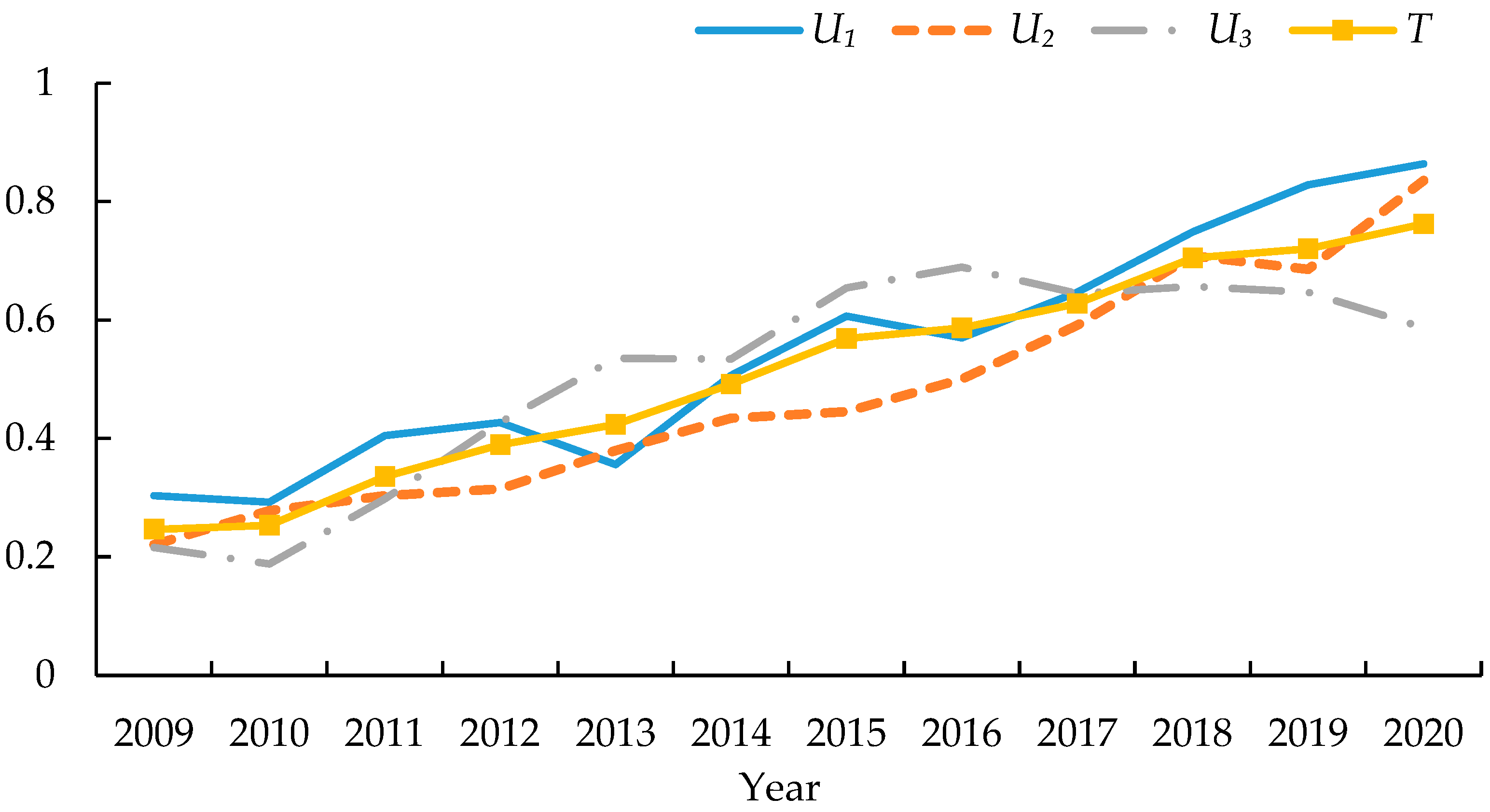
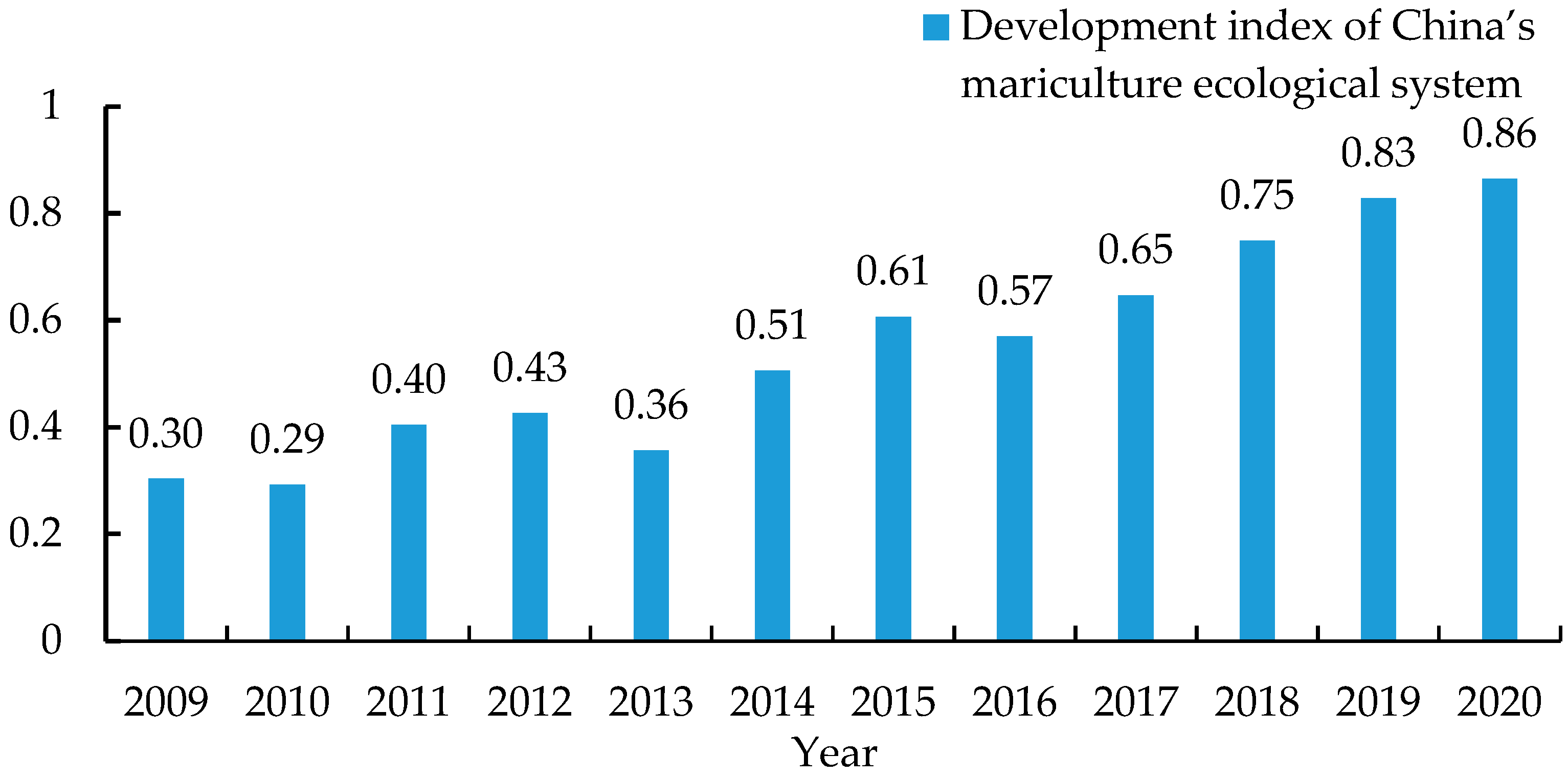
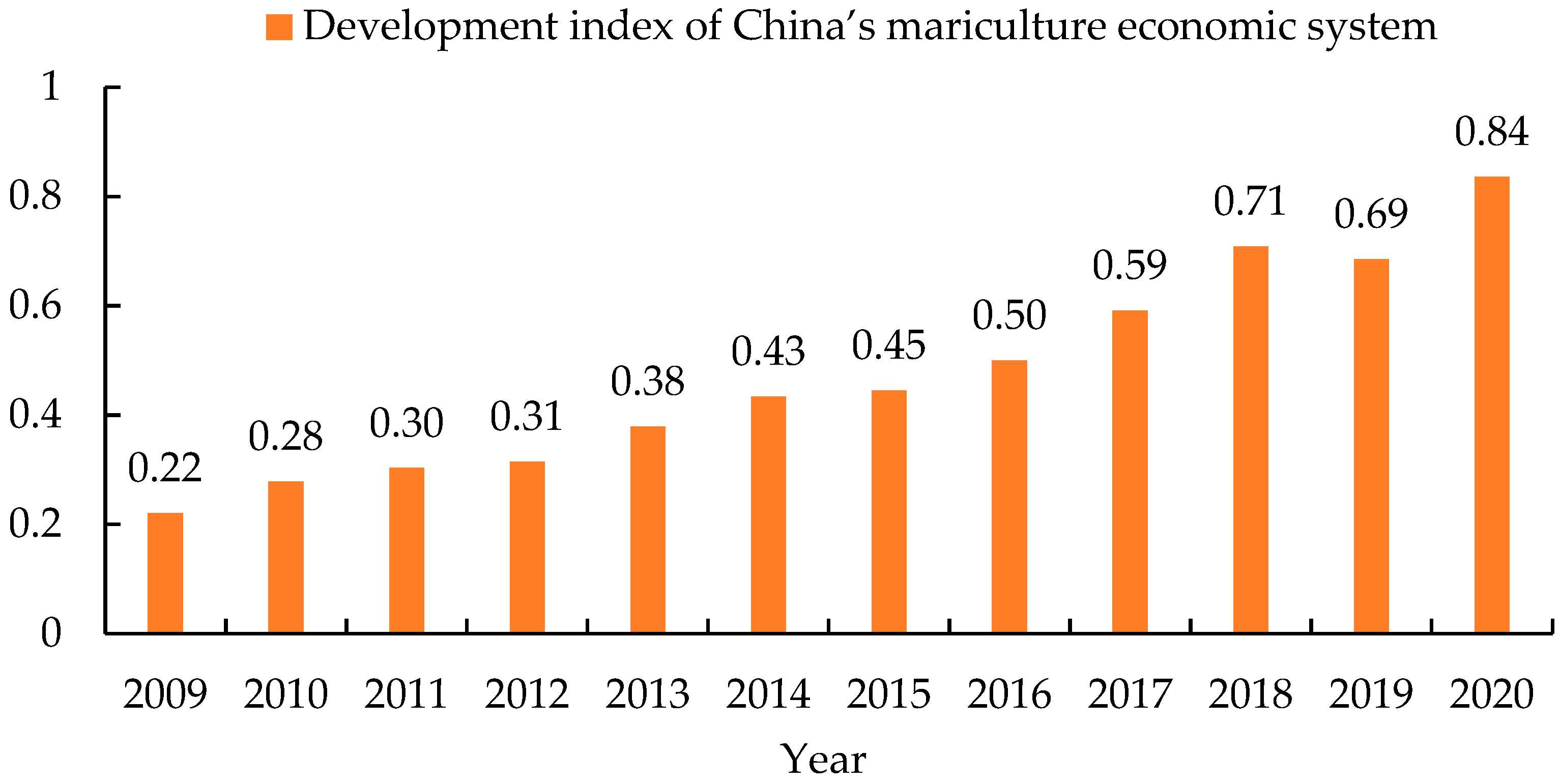
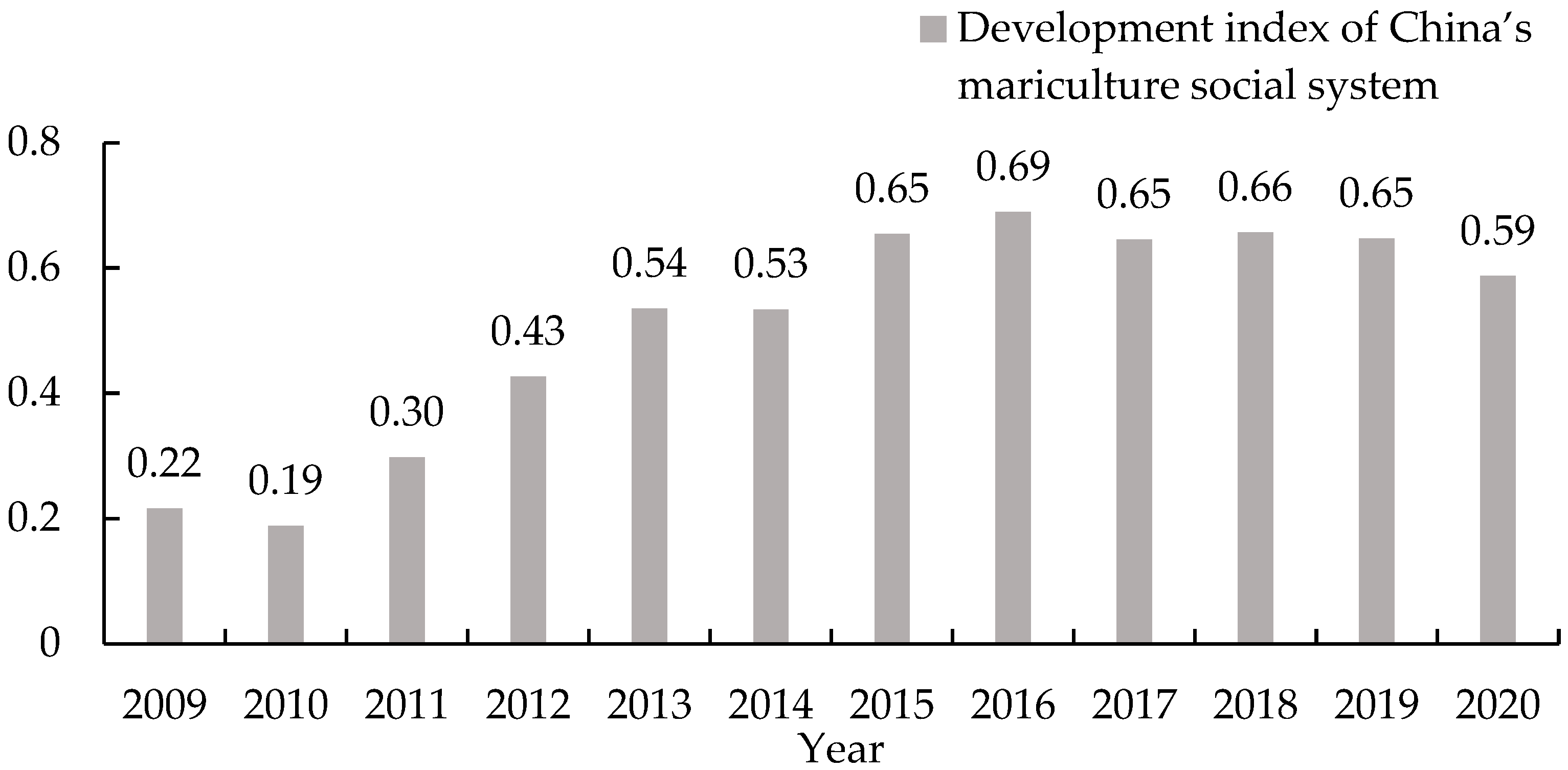
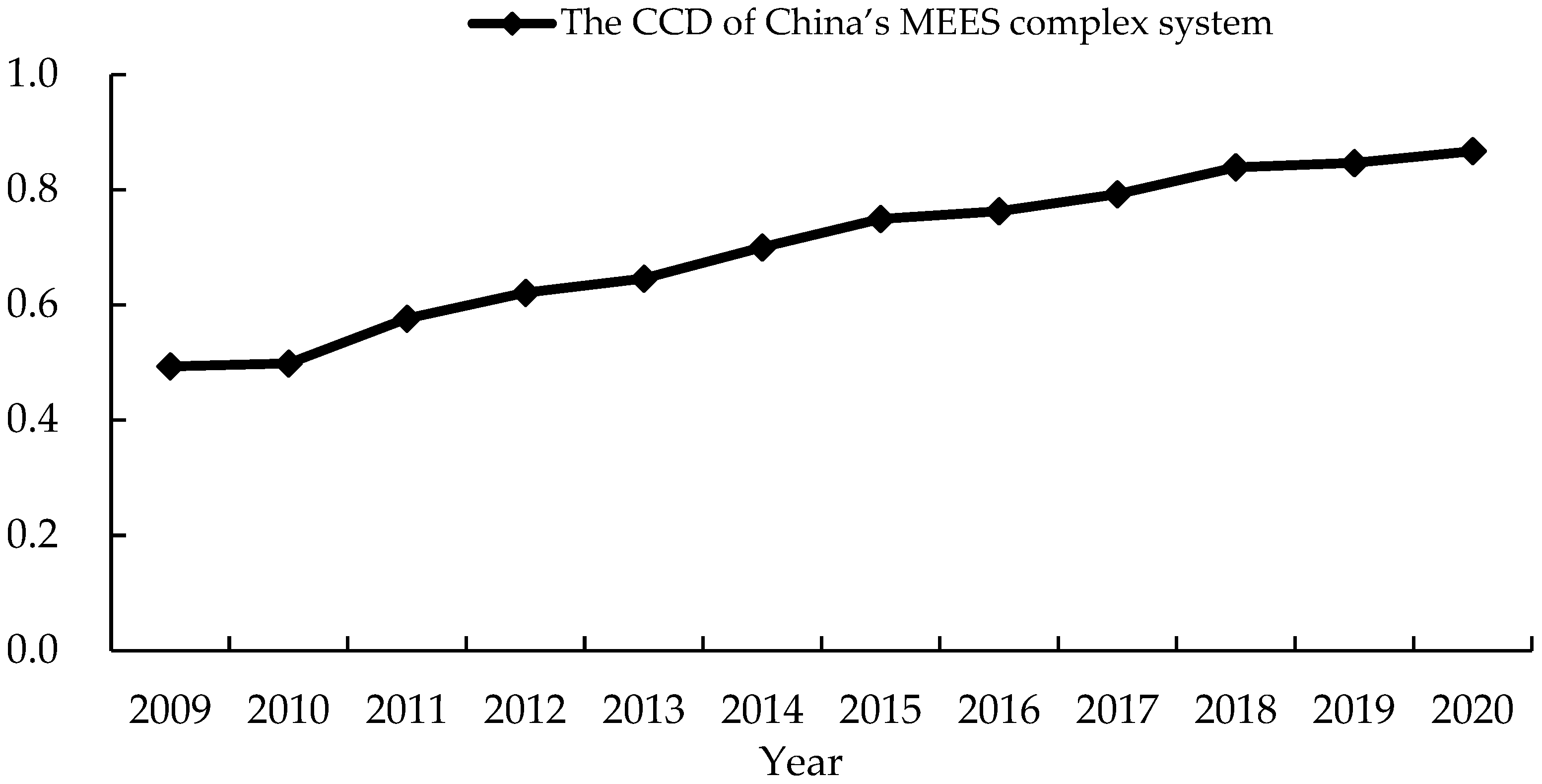
| Subsystems | Factor Level | Indicator | Type of Indicator | Weight |
|---|---|---|---|---|
| Mariculture ecological system | Resource condition | Area of mariculture (hectares) | Positive | 0.055 |
| Number of state-level aquaculture farms (nos.) | Positive | 0.079 | ||
| Proportion of autotrophs and heterotrophs in mariculture (%) | Positive | 0.123 | ||
| Environmental pollution | Percentage of the area of near-shore sea with good water quality (%) | Positive | 0.086 | |
| Total wastewater discharges from directly discharged sea pollution sources (tons) | Negative | 0.052 | ||
| Total chemical oxygen demand discharges from directly discharged sea pollution sources (tons) | Negative | 0.046 | ||
| Total petroleum discharges from directly discharged sea pollution sources (tons) | Negative | 0.051 | ||
| Total ammonia nitrogen discharges from directly discharged sea pollution sources (tons) | Negative | 0.042 | ||
| Total phosphorus discharges from directly discharged sea pollution sources (tons) | Negative | 0.086 | ||
| Ecological disaster | Sea level rise compared to normal (mm) | Negative | 0.052 | |
| Storm surge processes causing disasters (times) | Negative | 0.040 | ||
| Number of red tide occurrences with a maximum area of more than 100 square kilometers (inclusive) (times) | Negative | 0.084 | ||
| Vessels damaged by wave disasters (ships) | Negative | 0.044 | ||
| Number of people killed (including missing) by marine disasters (people) | Negative | 0.060 | ||
| Fishery disasters in coastal areas—loss of quantity of aquatic products (tons) | Negative | 0.062 | ||
| Typhoon and flood disasters in coastal areas—affected aquaculture area (hectares) | Negative | 0.036 | ||
| Mariculture economic system | Input level | Quantity of seawater fish fry stocked (10,000 fish) | Positive | 0.092 |
| Year-end ownership of mariculture motorized fisheries (vessels) | Positive | 0.047 | ||
| Year-end total power of mariculture motorized fisheries (kW) | Positive | 0.045 | ||
| Year-end total tonnage of mariculture motorized fisheries (tonnage) | Positive | 0.084 | ||
| Inputs to operating fisheries (RMB/person) | Positive | 0.043 | ||
| Output level | Mariculture production (million tons) | Positive | 0.053 | |
| Mariculture output value (tens of billions of yuan) | Positive | 0.051 | ||
| Growth rate of mariculture output value (%) | Positive | 0.047 | ||
| Mariculture output value as a share of fishery output value (%) | Positive | 0.051 | ||
| Per capita mariculture production of mariculture for professional mariculturists (kg/person) | Positive | 0.065 | ||
| Per capita mariculture output value of mariculture for professional mariculturists (RMB 10,000,000/person) | Positive | 0.052 | ||
| Level of mariculture yields (kg/ha) | Positive | 0.098 | ||
| Structural level | Share of intensive mariculture practices (%) | Positive | 0.088 | |
| Concentration of mariculture practices (%) | Negative | 0.051 | ||
| Concentration of mariculture species (%) | Negative | 0.035 | ||
| Share of mariculture production in marine products production (%) | Positive | 0.097 | ||
| Mariculture social system | Fishermen’s life | Per capita net income of fishermen (RMB/person) | Positive | 0.071 |
| Share of mariculture professionals in marine fishery population (%) | Positive | 0.057 | ||
| Per capita possession of mariculture products (kg/person) | Positive | 0.054 | ||
| Engel’s coefficient for rural households (%) | Negative | 0.086 | ||
| Management capacity | Number of marine fisheries law enforcement vessels (ships) | Positive | 0.074 | |
| Number of fisheries law enforcement agencies in coastal areas (units) | Positive | 0.056 | ||
| Number of operational agricultural meteorological observation stations in coastal areas (units) | Positive | 0.104 | ||
| Completed investment in industrial pollution control of wastewater in coastal areas (ten thousand yuan) | Positive | 0.076 | ||
| Completed investment in industrial pollution control of waste gas in coastal areas (ten thousand yuan) | Positive | 0.077 | ||
| Completed investment in industrial pollution control of solid waste in coastal areas (ten thousand yuan) | Positive | 0.050 | ||
| Technology promotion | Number of aquatic technology extension organizations in coastal areas (nos.) | Positive | 0.037 | |
| Percentage of senior titles of actual personnel in aquatic technology extension in coastal areas (%) | Positive | 0.105 | ||
| Funding for personnel of aquatic technology extension organizations in coastal areas (RMB 10,000,000) | Positive | 0.096 | ||
| Number of technical training periods for fishermen in aquatic technology extension in coastal areas (nos.) | Positive | 0.057 |
| Cluster | Centroid | Level Label |
|---|---|---|
| Cluster 1 | 0.250 | Poor |
| Cluster 2 | 0.382 | General |
| Cluster 3 | 0.561 | Good |
| Cluster 4 | 0.729 | Excellent |
| The Value of D | Level of Coordination | Interval Range | Type of Coordination |
|---|---|---|---|
| (0, 0.1) | Extreme dissonance | 0 ≤ D < 0.4 | Dissonance |
| (0.1, 0.2) | Severe dissonance | ||
| (0.2, 0.3) | Moderate dissonance | ||
| (0.3, 0.4) | Mild dissonance | ||
| (0.4, 0.5) | Near-dissonance | 0.4 ≤ D < 0.6 | Excess |
| (0.5, 0.6) | Barely coupling coordination | ||
| (0.6, 0.7) | Primary coordination | 0.6 ≤ D ≤ 1 | Coordination |
| (0.7, 0.8) | Intermediate coordination | ||
| (0.8, 0.9) | Good coordination | ||
| (0.9, 1.0] | Quality coordination |
| Score of Development Index | System Characteristics | Quality Level |
|---|---|---|
| 0 ≤ U1 < 0.4 | Deterioration of mariculture ecological environment, difficulties in restoration and reconstruction, backward economic and social development | Low |
| 0.4 ≤ U1 < 0.6 | Mariculture ecological environment is damaged to a certain extent, but it can be restored with better economic and social development | Medium |
| 0.6 ≤ U1 < 0.8 | Mariculture ecological damage to a lesser extent, resource depletion and environmental pollution are not obvious, with a medium–high level of economic and social development | Medium–high |
| 0.8 ≤ U1 ≤ 1 | Mariculture ecological environment has excellent service functions, sufficient resources, and no environmental pollution, with a high level of economic and social development | High |
| Year | 2009 | 2010 | 2011 | 2012 | 2013 | 2014 | 2015 | 2016 | 2017 | 2018 | 2019 | 2020 |
|---|---|---|---|---|---|---|---|---|---|---|---|---|
| C | 0.988 | 0.982 | 0.990 | 0.990 | 0.984 | 0.996 | 0.987 | 0.991 | 0.999 | 0.999 | 0.994 | 0.985 |
| D | 0.493 | 0.498 | 0.576 | 0.621 | 0.645 | 0.699 | 0.749 | 0.762 | 0.792 | 0.839 | 0.846 | 0.867 |
| Level | Near-dissonance | Near-dissonance | Barely coupling coordination | Primary coordination | Primary coordination | Primary coordination | Intermediate coordination | Intermediate coordination | Intermediate coordination | Good coordination | Good coordination | Good coordination |
Disclaimer/Publisher’s Note: The statements, opinions and data contained in all publications are solely those of the individual author(s) and contributor(s) and not of MDPI and/or the editor(s). MDPI and/or the editor(s) disclaim responsibility for any injury to people or property resulting from any ideas, methods, instructions or products referred to in the content. |
© 2025 by the authors. Licensee MDPI, Basel, Switzerland. This article is an open access article distributed under the terms and conditions of the Creative Commons Attribution (CC BY) license (https://creativecommons.org/licenses/by/4.0/).
Share and Cite
Pei, R.; Zhang, H.; Mu, Y.; Sakib, M.H.; Zhang, Y.; Liu, X.; Huang, X.; Ge, A.; Pei, R.; Wang, R. Mechanism and Measurement of Coordinated Development in the Mariculture Ecological–Economic–Social Complex System: A Case Study of China. Water 2025, 17, 2878. https://doi.org/10.3390/w17192878
Pei R, Zhang H, Mu Y, Sakib MH, Zhang Y, Liu X, Huang X, Ge A, Pei R, Wang R. Mechanism and Measurement of Coordinated Development in the Mariculture Ecological–Economic–Social Complex System: A Case Study of China. Water. 2025; 17(19):2878. https://doi.org/10.3390/w17192878
Chicago/Turabian StylePei, Runsheng, Hongzhi Zhang, Yongtong Mu, Md. Hashmi Sakib, Yingxue Zhang, Xin Liu, Xia Huang, Aiqin Ge, Runfeng Pei, and Ruohan Wang. 2025. "Mechanism and Measurement of Coordinated Development in the Mariculture Ecological–Economic–Social Complex System: A Case Study of China" Water 17, no. 19: 2878. https://doi.org/10.3390/w17192878
APA StylePei, R., Zhang, H., Mu, Y., Sakib, M. H., Zhang, Y., Liu, X., Huang, X., Ge, A., Pei, R., & Wang, R. (2025). Mechanism and Measurement of Coordinated Development in the Mariculture Ecological–Economic–Social Complex System: A Case Study of China. Water, 17(19), 2878. https://doi.org/10.3390/w17192878






